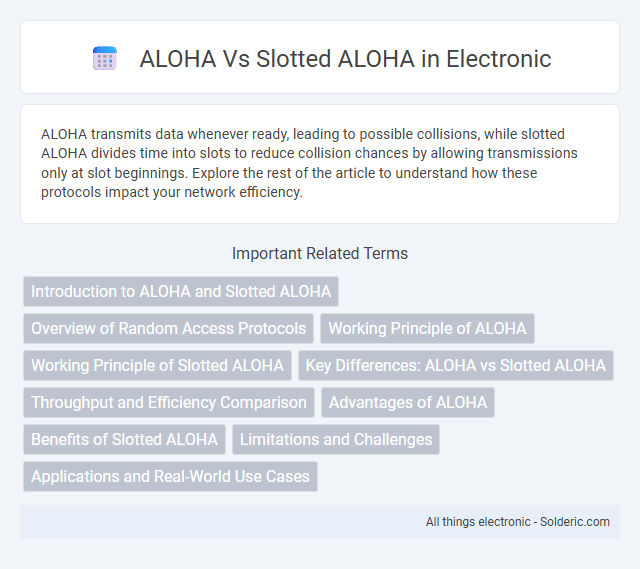ALOHA transmits data whenever ready, leading to possible collisions, while slotted ALOHA divides time into slots to reduce collision chances by allowing transmissions only at slot beginnings. Explore the rest of the article to understand how these protocols impact your network efficiency.
Comparison Table
| Feature | ALOHA | Slotted ALOHA |
|---|---|---|
| Time Division | No time slots, users transmit anytime | Divides time into discrete slots for transmission |
| Collision Probability | Higher, due to asynchronous transmissions | Reduced by half compared to pure ALOHA |
| Throughput | Maximum 18.4% channel utilization | Maximum 36.8% channel utilization |
| Synchronization | Not required | Required to coordinate slots |
| Implementation Complexity | Simple, easy to implement | Moderate complexity due to slot synchronization |
| Use Case | Low traffic networks, simple setups | Networks requiring improved efficiency |
Introduction to ALOHA and Slotted ALOHA
ALOHA is a simple communication protocol used for wireless networks to handle data transmission where devices transmit whenever data is ready, resulting in possible collisions. Slotted ALOHA improves efficiency by dividing time into discrete slots, allowing devices to transmit only at the start of these slots, thereby reducing collisions by half compared to pure ALOHA. Understanding the differences between ALOHA and Slotted ALOHA can help optimize your network's throughput and minimize data packet collisions.
Overview of Random Access Protocols
ALOHA and Slotted ALOHA are foundational random access protocols used in wireless communications to manage channel access. ALOHA allows devices to transmit data whenever ready, leading to potential collisions and a maximum throughput of about 18.4%. Slotted ALOHA improves efficiency by dividing time into discrete slots for transmission, reducing collisions and increasing maximum throughput to approximately 36.8%.
Working Principle of ALOHA
ALOHA operates by allowing devices to transmit data whenever they have information to send, leading to potential collisions when multiple devices transmit simultaneously. The system relies on acknowledgments and retransmissions after random delays to manage these collisions and maintain communication integrity. Your network efficiency improves by understanding that ALOHA's uncoordinated access contrasts with the time-slot synchronization in slotted ALOHA, reducing collision probability.
Working Principle of Slotted ALOHA
Slotted ALOHA divides time into discrete slots equal to the packet transmission time, allowing stations to transmit only at the beginning of a time slot. This synchronization reduces collisions by limiting transmissions to specific intervals, enhancing channel efficiency compared to pure ALOHA. Each slot can accommodate one packet, and if multiple stations transmit simultaneously within a slot, a collision occurs, necessitating retransmission in subsequent slots.
Key Differences: ALOHA vs Slotted ALOHA
ALOHA operates with continuous transmission, leading to higher collision probability, while Slotted ALOHA divides time into discrete slots, reducing collisions by synchronizing transmissions. Slotted ALOHA achieves double the efficiency of pure ALOHA, reaching up to 37% channel utilization compared to ALOHA's 18%. Your network's performance improves significantly when using Slotted ALOHA due to its time-slot synchronization minimizing wasted bandwidth.
Throughput and Efficiency Comparison
Slotted ALOHA doubles the throughput of pure ALOHA by reducing the vulnerable period for collisions from two frame times to one, achieving a maximum throughput of approximately 0.37 compared to pure ALOHA's 0.18. This improvement results from time synchronization into discrete slots that minimize overlapping transmissions, thereby increasing channel efficiency. As a result, slotted ALOHA offers significantly better efficiency in high-traffic networks, making it preferable for environments demanding higher throughput and lower collision rates.
Advantages of ALOHA
ALOHA offers simplicity and ease of implementation by allowing devices to transmit whenever they have data, without requiring synchronization. This unslotted approach reduces protocol overhead and latency, making it suitable for low-traffic or sporadic communication environments. Its flexibility supports a wide range of applications where strict timing constraints are unnecessary.
Benefits of Slotted ALOHA
Slotted ALOHA improves channel efficiency by dividing time into discrete slots, allowing devices to transmit only at the start of each slot and reducing the probability of collisions. This synchronization mechanism doubles the throughput compared to pure ALOHA, achieving a maximum efficiency of approximately 37%. The protocol minimizes idle times and optimizes bandwidth utilization in wireless communication networks, making it suitable for time-sensitive data transmissions.
Limitations and Challenges
ALOHA faces significant limitations due to high collision rates in unsynchronized transmissions, resulting in lower channel efficiency of about 18.4%. Slotted ALOHA improves efficiency to roughly 36.8% by dividing time into discrete slots, but it requires precise synchronization, which can be costly and complex to implement. You must consider that both protocols struggle with scalability under heavy traffic, as increased collisions can severely degrade performance.
Applications and Real-World Use Cases
ALOHA is widely applied in satellite and wireless communication systems where simplicity and random access to the channel are essential, such as early packet radio networks and low-traffic IoT devices. Slotted ALOHA improves efficiency by dividing time into discrete slots, making it suitable for networks requiring better throughput and collision control, like RFID systems and certain WLAN configurations. Understanding these protocols helps you select the appropriate method for scenarios demanding different levels of latency, throughput, and complexity.
ALOHA vs slotted ALOHA Infographic

 solderic.com
solderic.com